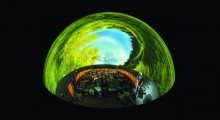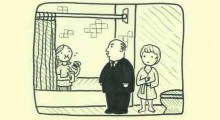Issues
-
Haunted Houses and Hidden Spaces

The Dark Net: Inside the Digital Underworld Behind the familiar Internet most of us inhabit skulks the dark net: unlinked, encrypted, password-protected sites and pages serving as forums for everything from marijuana-by-mail sales to mutual suicide webcam pacts. Author Jamie Bartlett is director of the Centre for Analysis of Social Media at the United Kingdom think tank Demos, which makes him well qualified to dive in and find out what the deeper implications of the dark net might be. Some British reviewers have taken issue with Bartlett’s optimistic assessment that these unregulated channels are by and large a good thing; […]
-
Editor’s Letter
If you’re a regular Filmmaker reader, you know that we’re obsessed about how the world of film is changing. But sometimes whatever is new and upcoming on the horizon has actually already arrived. Have you noticed? All those things that we chatter about here in our line items and articles and in these Editor’s Letters, well, they are almost old news. That is, if you’re not up on the new landscape, you’re not in the game. Compile a list of funders and distributors these days, and you’ll include alongside all the usual suspects Netflix and Amazon, who are now not […]
-
Teaching Immersion and Stereoscopy

The profusion of virtual reality projects showcased at the 2015 Sundance Film Festival is a testament to the fact that the tools and techniques for cinematic storytelling are expanding. Film schools are adapting, often quickly creating new courses that attempt to help students navigate this new frontier. My colleague Eric Hanson, for example, now teaches a course in University of Southern California’s School of Cinematic Arts called “Experiments in Immersive Design.” The course was originally designed to help students understand the history, theory and practice of three-dimensional filmmaking. But under Hanson it has shifted more to incorporate his background and […]
-
I’ll Come Running: Alfonso Gomez-Rejon and Jesse Andrews on Me and Earl and the Dying Girl

Those are people who died, died! They were all my friends, and they died! — Jim Carroll Do you remember your first experience with death? Most likely it was a grandparent passing. Or maybe a parent? Or, quite possibly, someone you knew at school, whether or not that person was a close friend. I remember mine — the younger brother of an elementary school classmate. He’d always prank on his older brother in the line to get into school each day, sneaking up on him from behind and then grabbing his lunch bag. A tug of war would ensue, the […]
-
The Silent Treatment: Director Miroslav Slaboshpitsky on The Tribe

The word “bravura” gets thrown around all too often in the realm of ambitious filmmaking (perhaps in arts criticism in general?), but there is seemingly no other word to describe the colossal craft on display in Ukrainian helmer Miroslav Slaboshpitsky’s Cannes 2014-premiering debut feature, The Tribe. The film’s narrative — which hews somewhat to the genre obligations of a Western, as Slaboshpitsky points out — concerns a young man, Sergey (Grigoriy Fesenko), who is a newcomer at a deaf boarding school in Ukraine. No sooner has Sergey arrived than he realizes that the school is run by its administration in […]
-
A Band Apart: Crystal Moselle on The Wolfpack

It’s a stretch of the Lower East Side like any other, with public housing towers looming unostentatiously overhead. One of these is the home of the Angulo brothers — six siblings confined for years (save sporadic supervised walks) to their apartment by their father, Oscar. Crystal Moselle’s first feature The Wolfpack — winner of the Documentary Grand Jury Prize at this year’s Sundance Film Festival — is the result of an accidental street meeting between the documentarian and her future subjects just as they were starting to regularly go outside in defiance of their dad. There are obvious questions of […]
-
The Seven Arts of Working in Film: A Necessary Guide to On-Set Protocol

Welcome to your first day on a film set. Perhaps you’ve gotten a new job as a production assistant. Perhaps you’re still in school and have been given an opportunity as an intern, or you’ve recently been asked to help out with a friend’s production. You probably have some questions. I’m writing this because I’d like to try to answer some of those questions in advance, and because I have hope. Hope that maybe the next time I ask someone to sweep up some glass that just broke, I won’t have to explain where to get a broom, how to […]
-
Blackmagic Announces New Cameras at NAB

It’s NAB, and Blackmagic have once again announced some exciting new cameras. Blackmagic has developed a bit of a reputation for announcing cameras with amazing specifications at incredibly good prices. They may not be as refined as the cameras from Sony, Canon et al., and they may not always ship on their announced dates, but if you’re a shooter on a budget you have to look at Blackmagic’s camera offerings. Blackmagic’s first camera was the Cinema Camera. Despite its unusual shape and user interface, this camera was a hit because of its high dynamic range, reasonable price, and its support […]
-
Crowdsourcing Erotica: Erika Lust’s XConfessions

A Swede living in Spain with a background in political science, Erika Lust is not your average feminist pornographer. The award-winning writer-director of over half a dozen erotic films, Lust is now embarking on what she considers her most important project yet. XConfessions is 100 percent crowdsourced, fan-generated erotica. Each month, Lust chooses two sex confessions from among the wide-ranging slew of fantasies posted to her site. (The submission process itself is free of charge. Just create an anonymous profile and you can read or write confessions as well as watch free videos.) Those favorites will then become short films […]
-
Dispatches from CPH:DOX and Borscht 9

International Copenhagen Documentary Film Festival – CPH:DOX 2014 by Pamela Cohn There is no way by which the events of the world can be directly transmitted or recorded in our brains. They are experienced and constructed in a highly subjective way. Our only truth is narrative truth, the stories we tell each other, and ourselves, the stories we continually re-categorize and refine. This sort of sharing — this communion — would not be possible if all our knowledge, our memories, were tagged and identified and seen as private, exclusively ours. —from Martin Scorsese and David Tedeschi’s film The 50 Year […]
